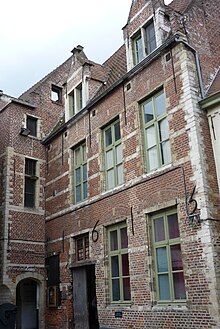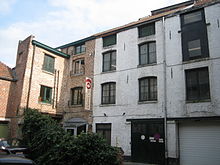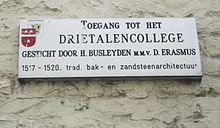Collegium Trilingue
The Collegium Trilingue , or Collegium trium linguarum (today's Dutch name: Drietalencollege or College van Busleyden , older Flemish name: Dry Tonghen , French Collège des Trois Langues ) was an early modern institution from 1518 to 1797 for the study of the three holy languages, Hebrew , Greek and Latin and was in Leuven . It is sometimes also called Collegium Buslidianum or Collegium Busleidianum after its founder .
history
The Collegium was founded in 1517 by the wealthy humanist Hieronymus Buslidius (Dutch: Jeroen van Busleyden , French: Jérôme de Busleyden ) through his last will. Hieronymus Buslidius was a member of the Great Council of Mechelen and had a magnificent residence built in Mechelen, the so-called Hof van Busleyden . He belonged to an important family in the Burgundian Netherlands , which had its origins in Bauschleiden in Luxembourg . His well-known brothers include Frans van Busleyden , the tutor of Archduke Philip and provost of Bruges, and Aegidius (Gilles) van Busleyden, the burgrave of Grimbergen .
Hieronymus Buslidius was friends with numerous scholars during his lifetime. These included Thomas More , who wrote the first part of his well-known work Utopia in Buslidius' residence in Mechelen , as well as Erasmus of Rotterdam , who then inspired Buslidius to found the college. After the death of Buslidius in August 1517, Erasmus was assisted in the implementation of the last will by Hieronymus' brother Aegidius (Gilles) van Busleyden. In September 1518, a good year after the death of Buslidius, the Collegium Buslidianum , as it was often called, was inaugurated. In his will, which was written in Latin, Buslidius had laid down exactly how the teaching should take place. Among other things, the praeceptores (lecturers) were obliged to hold public lectures free of charge. The building that was erected at that time, however, has undergone extensive renovations and conversions over the centuries, so that today only a small part of the building is more or less true to the original. In this part there is now a bistro.
The collegium was not part of the university , but came from the initiative of humanists who wanted to promote the study of ancient languages , which had been pushed into the background in the Middle Ages . For this purpose, Erasmus selected the best teachers of Latin, Greek and Hebrew.
The college ceased its activities in 1797 when, in the wake of the French Revolution, all universities were abolished and their properties were confiscated. The courses in Latin had been discontinued as early as 1768 due to a lack of demand. The students either already had a good knowledge of Latin at the start of their studies or were able to perfect them at the university.
The renaissance building on Busleydengang near the fish market ( vismarkt ) in Leuven has been largely preserved to this day. However, it has undergone numerous renovations and conversions over the years.
Teacher at the Collegium Trilingue
The following is a full list of teachers at the Collegium Trilingue .
Teacher of Latin
- 1518–1519 Hadrianus Barlandus
- 1519–1539 Conradus Goclenius (Conrad Goekelen) (1489–1539)
- 1539–1557 Petrus Nannius (Pieter Nanninck) (1500–1557)
- 1557–1578 Cornelius Valerius
- 1586-15xx Guilielmus Huismannus
- 1606–1606 Justus Lipsius
- 1607-1646 Eryceus Puteanus
- 1646–1649 Nicolaus Vernulaeus
- 1649–1664 Bernadus Heimbachius
- 1664–1669 Christianusa Langendonck
- 1669–1683 Joannes Baptista Victor de Schuttelaere
- 1683-1688 Dominicus Snellaerts
- 1683–1693 Leonardus Gautius
- 1689–1701 Bernardus Desirant
- 1705–1720 Jean Francois de Laddersous
- 1730–1741 Christianus Bombaeus
- 1722–1738 Gerard Jean Kerckherdere
- 1741–1768 Henri Joseph van der Steen
Teacher of Greek
- 1518–1545 Rutgerus Rescius (Rutger Ressen) (14xx-1545)
- 1545–1560 Hadrianus Amerotius
- 1560–1578 Theodoricus Langius
- 1578-1590 Guilielmus Fabius
- 1591–1596 Gerardus Corselius
- 1606–1607 Henricus Zoesius
- 1609–1632 Petrus Castellanus
- 1632–1643 Petrus Stockmans
- 1643–1652 Mathieu Theige
- 1652-1654 Jean Normenton
- 1654–1664 Bernardus Heymbachius
- 1664-1680 Jean de Hamere
- 1681–1690 Rutger van den Burgh
- 1683-1722 Francois Martin
- 1723–1732 Franciscus Audenaert
- 1723–1740 Francois Claude de Guareux
- 1741–1782 Jean-Baptiste Zegers
- 1782–1787 Jean Hubert Joseph Leemput
- 1790–1791 Jean-Baptiste Cypers
- 1791–1797 Antoine van Gils
Hebrew teacher
- 1518–1519 Mattheus Adrianus
- 1519–1519 Robertus Wackfeldus
- 1519–1519 Robertus Shirwodus
- 1520–1531 Johannes Campensis
- 1532–1568 Andreas Gennepius
- 1568–1569 Johannes Guilielmus Harlemicus
- 1569–1577 Petrus Pierius a Smenga
- 1612–1655 Valerius Andreas
- 1656–1679 Joannes Sauterus
- 1679–1704 Jean Herrys
- 1704–1723 Jean Guillaume van Hove
- 1726–1750 Gilbert Joseph Hagen
- 1755-1772 Jean Noel Paquot
- 1774–1782 Gerard Deckers
- 1782–1786 Joseph Benoit de Mazière
- 1790–1797 Etienne Heuschling
Well-known alumni
- Gemma R. Frisius (1508–1555)
- Gerhard Mercator (1512–1594)
- Andreas Vesalius (1514–1564)
- Ogier Ghislain de Busbecq (1521 / 22–1592)
- Carolus Clusius (1526-1609)
- Andreas Schott (1552–1629)
- Petrus Castellanus (Peeter van de Casteele) (1585–1632)
Institutions based on the model of the Collegium Trilingue
The Collegium Carolinum in Zurich
Based on the Löwen model, Ulrich Zwingli founded the Collegium Carolinum in Zurich as Collegium Trilingue, which opened in 1525 .
The Collège de France in Paris
When it was founded in 1530 under King Francis I, the Collège de France in Paris was also designed as a Collegium Trilingue ( Collège des trois langues ) based on the Löwen model . Erasmus had been invited to teach there, but declined.
The Collegium Trilingue Foundation in Vienna
In 1539/40, Bishop Johann Fabri established the St. Nikolaus Student Convict in Vienna under the name Collegium trilingue .
Modern facilities
The theological-propaedeutic seminar Ambrosianum in Tübingen is currently an institution of this type.
literature
- Félix Nève: Mémoire historique et littéraire sur Le Collége (sic) des Trois-Langues à l'Université de Louvain. M. Hayez, Brussels, 1856, (online) .
- Jan Papy (Ed.): The Leuven Collegium Trilingue 1517–1797. Erasmus, Humanist Educational Practice and the New Language Institute Latin-Greek-Hebrew. Peeters, Leuven 2018. - Review by Andrea Hugill, Bryn Mawr Classical Review 2019.07.41 .
- Henry de Vocht: History of the foundation and the rise of the Collegium Trilingue Lovaniense, 1517-1550. 4 vol., Librairie Universitaire, Louvain 1951–1955 ( Humanistica Lovaniensia , n ° 10–13).
- Henry de Vocht: Les Débuts du Collège Trilingue de Louvain, 1517–1550. Uytspruyt, Louvain 1958.
Web links
- Literature by and about Collegium Trilingue in the SUDOC catalog (Association of French University Libraries)
- Katholieke Universiteit Leuven , Vesaliusonline: Het Collegium Trilingue (in Dutch; with photographs of the building)
- Inventoryis Onroerend Erfgoed: Collegium Trilingue (in Dutch; database of the monument protection of the Flemish government)
Individual evidence
- ↑ De inventoryis van het Bouwkundig Erfgoed , at onroerenderfgoed.be
- ↑ Hieronymus Buslidius , at deutsche-biographie.de
- ↑ Hiëronymus van Busleyden , at mechelen.mapt.be
- ↑ De droom van Erasmus - Het Collegium Trilingue ( Memento of the original of July 27, 2014 in the Internet Archive ) Info: The archive link was inserted automatically and has not yet been checked. Please check the original and archive link according to the instructions and then remove this notice. , at juliaenelias.be
- ^ Léon E. Halkin: Érasme parmi nous. Fayard, Paris 1987, pp. 174-175.
- ^ Félix Nève: Mémoire historique et littéraire sur Le Collége (sic) des Trois-Langues à l'Université de Louvain. M. Hayez, Bruxelles, 1856, (online) .
- ↑ Ulrike Denk: Private scholarship foundations at the University of Vienna . In: Mitteilungen der Österreichische Gesellschaft für Wissenschaftsgeschichte 20, 2000, pp. 163–180, here pp. 168–171.
Coordinates: 50 ° 52 ′ 52 ″ N , 4 ° 42 ′ 1 ″ E





